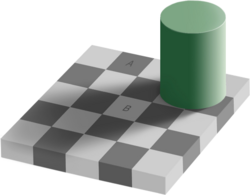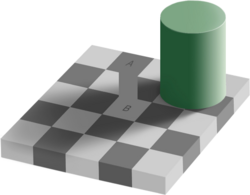Same color illusion
The same color illusion (also known as Adelson's checker shadow illusion, checker shadow illusion and checker shadow) is an optical illusion in which identical shades of gray appear to be different.
Discovery
The same color illusion was first published in 1995 by Edward H. Adelson, Professor of Vision Science at Massachusetts Institute of Technology (MIT).[1]
Description
The same color illusion shows what appears to be a checkerboard made of dark and light gray squares. Resting in one corner of the checkerboard is a green cylinder that casts a shadow diagonally across the middle of the board. Two of the squares on the board are labeled "A" and "B". When studying the image, square A appears markedly darker than square B, even though they are the exact same shade of gray. If one removes the image surrounding the two squares (or covers it over with a paper), it is clear that they are the same shade.
This illusion is seen on checkerboard patterns in a variety of forms, including what Adelson calls the "corrugated Mondrian." This takes the form of a checkerboard pattern drawn to look as if it is painted on a three-dimensional structure, adding further complexity to our perception.Cite error: Closing </ref> missing for <ref> tag
Applications
Illusions of lightness and brightness can help reveal the nature of lightness computation in the human visual system. The same color illusion aptly demonstrates why it is so important to verify what may seem like obvious assumptions when conducting scientific experiments. The human eye and brain can be easily fooled into misinterpretations, which could affect the results of any number of scientific inquiries.
Notes
- ↑ Adelson, Edward H. (2005). Checkershadow Illusion. Retrieved 2007-04-21.
ReferencesISBN links support NWE through referral fees
- Adelson, Edward H. Adelson. 2000. Lightness Perception and Lightness Illusions in Michael S. Gazzaniga, ed., The New Cognitive Neurosciences. Cambridge, MA: MIT Press. Retrieved November 22, 2007. ISBN 978-0262071956
- Hoffman, Donald D. 2000. Visual Intelligence: How We Create What We See. W. W. Norton. ISBN 0393319679
External links
All links Retrieved November 16, 2007.
Credits
New World Encyclopedia writers and editors rewrote and completed the Wikipedia article in accordance with New World Encyclopedia standards. This article abides by terms of the Creative Commons CC-by-sa 3.0 License (CC-by-sa), which may be used and disseminated with proper attribution. Credit is due under the terms of this license that can reference both the New World Encyclopedia contributors and the selfless volunteer contributors of the Wikimedia Foundation. To cite this article click here for a list of acceptable citing formats.The history of earlier contributions by wikipedians is accessible to researchers here:
The history of this article since it was imported to New World Encyclopedia:
Note: Some restrictions may apply to use of individual images which are separately licensed.

